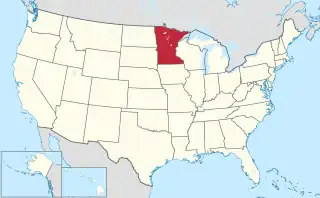
There are nineteen official symbols of the US state of Minnesota, as designated by the Minnesota Legislature.[1] The first named symbol is the state's motto, L'Étoile du Nord – French for "Star of the North". It was selected in 1861, shortly after Minnesota achieved statehood, by the first governor, Henry Sibley, as a reflection of Minnesota's location in the Northern United States. That same year, the state seal was appointed. Minnesota did not designate another official symbol until 1945, when "Hail! Minnesota", then the official song of the University of Minnesota, was designated as state song. In 1984, Minnesota became the first state to appoint a state mushroom, the common morel (Morchella esculenta).[1]
Minnesota schoolchildren have been the force behind the successful promotion of four official symbols: the blueberry muffin (1988), the monarch butterfly (2000), the Honeycrisp apple (2006), and ice hockey (2009). The 1918 black-and-white photograph Grace, taken by Eric Enstrom in Bovey and later reproduced as a color painting by his daughter, was named state photograph in 2002. The newest symbol of Minnesota is the rusty patched bumblebee, declared the state bee in 2019. In addition, many other symbols have been proposed as representations of the state, but for various reasons have been unsuccessful. Suggested animals have included the white-tailed deer, the northern leopard frog, the eastern timber wolf, the thirteen-lined ground squirrel, and the Blanding's turtle. Through the years, the state legislature has also voted on unsuccessful bills to designate the Tilt-A-Whirl as official amusement ride, the works Little House on the Prairie and On the Banks of Plum Creek as state book, "Minnesota Blue" as official poem, as well as the appointment of a poet laureate position.
State symbols
| Type[1] | Symbol[1] | Description | Adopted[1] | Image |
|---|---|---|---|---|
| Bee | Rusty patched bumblebee (Bombus affinis) |
Once widespread across the United States, the rusty patched bumblebee has lost up to 90% of its range since the 2000s. Sightings in the 2010s were primarily reported around several upper Midwest urban areas; a third of these were in Minneapolis and Saint Paul.[2] | 2019 | .jpg.webp) |
| Beverage | Milk | Minnesota annually produces 9.7 billion pounds of milk, and among all states is ranked fifth in overall dairy production.[3] Milk was adopted as the state beverage due to its promotional value for the American Dairy Association; its ability to encourage tourism and increase awareness for dairy products; and as a signal to the state's dairy industry that Minnesota cares for it.[1] | 1984 |  |
| Bird | Common loon (Gavia immer) |
An estimated 12,000 common loons reside in Minnesota.[4] Originally, eight bird choices were proposed in the late 1940s, which in addition to the common loon included the eastern goldfinch, the mourning dove, the pileated woodpecker, the scarlet tanager, and the wood duck.[1] Each of these were eligible because they were not the state birds of another state. A decision was delayed due to citizen indecision, but a letter-writing campaign over a decade after the original proposal led to the selection of the loon.[5] | 1961 | 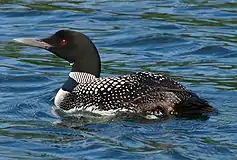 |
| Butterfly | Monarch (Danaus plexippus) |
The monarch migrates to Minnesota during midsummer,[6] where approximately four generations are born each year.[7] It was promoted as state butterfly by several students of Oscar Henry Anderson Elementary School from Mahtomedi. The bill's co-sponsor, State Representative Harry Mares, said that "a lot of people have an early introduction to the magical world of nature through the monarch, and as we get older it becomes a thread that takes us through science to beauty and aesthetics."[1] | 2000 |  |
| Fish | Walleye (Stizostedion vitreum) |
The Star Tribune writes that the walleye is Minnesota's most popular fish, and it serves as "the mainstay of sport fishing" in the state.[8] The walleye lives in every watery part of Minnesota, but prefers the cooler lakes of the northern part of the state.[9] It was first proposed as the state fish in 1953.[1] | 1965 | 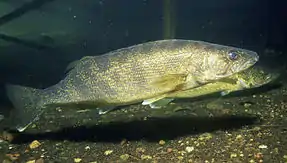 |
| Flag | Flag of Minnesota | The Minnesota flag is royal blue with a gold fringe, and has the state seal displayed at its center. The state flower, the pink-and-white lady's slipper, comprises a wreath surrounding the seal. Minnesota was the nineteenth state to join the United States after the original 13 colonies (Minnesota was the 32nd state to join the union); this is reflected in the flag's nineteen stars, with the largest representing the North Star. The flag also displays the word "Minnesota" as well as the state's motto, L'Étoile du Nord.[10] The flag's current design was adopted in 1957, and has since undergone numerous proposed, though unsuccessful, revisions.[1] | 1957 |  |
| Flower | Pink-and-white lady's slipper (Cypripedium reginae) |
The pink-and-white lady's slipper is found in swamps, bogs, and damp woods. It has largely disappeared due to habitat loss; as one of Minnesota's rarest wildflowers, the lady's slipper is illegal to pick in the state.[11][12] | 1967 | 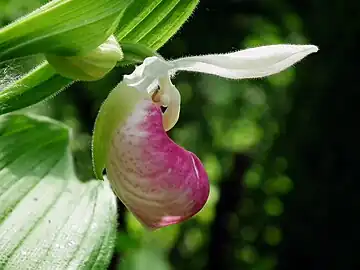 |
| Fruit | Honeycrisp apple (Malus pumila) |
The Honeycrisp apple was designed by University of Minnesota researchers to endure Minnesota's harsh winter climate.[13] It was proposed as the state fruit by Andersen Elementary School students from Bayport.[1] | 2006 |  |
| Gemstone | Lake Superior agate | Found in the northeastern and north central parts of Minnesota, the Lake Superior agate consists of quartz blended with the red and orange effects that come from soil rich in iron ore.[14] | 1969 |  |
| Grain | Wild rice (Zizania palustris) |
Wild rice grows in central and northern Minnesota lakes, and for a long time was produced nowhere else.[15] As of 2013, Minnesota produces 80 percent of all natural wild rice.[11] The Ojibwe people hold it sacred, believing it was given to them by their Creator.[16] | 1977 | .jpg.webp) |
| Motto | L'Étoile du Nord | L'Étoile du Nord is French for "Star of the North". It was chosen by Henry Sibley, the state's first governor, shortly after the Minnesota territory became a state in 1858. Sibley selected it as a reflection of Minnesota's location so far north in the US.[17] | 1861 |  |
| Muffin | Blueberry muffin | Northeastern Minnesota is home to wild blueberries, where they grow in bogs and forests.[18] The blueberry muffin was proposed as a state food by South Terrace Elementary students from Carlton, who were learning about the state legislature and its laws in their civics class.[11][19] | 1988 |  |
| Mushroom | Common morel (Morchella esculenta) |
In the spring, morel mushrooms can be found in Minnesota fields and forests.[20] They primarily grow in the southwest, northern, and middle parts of the state,[21] and are popular with gourmet cooks.[11] | 1984 |  |
| Photograph | Grace | Grace depicts a man sitting "at a table bowed in thankful prayer before a modest meal."[22] The original 1918 black-and-white photograph was taken by Eric Enstrom in Bovey. Enstrom's daughter later reproduced it as a color painting,[23][24] leading to its wide distribution in homes and churches throughout the US.[25] | 2002 | 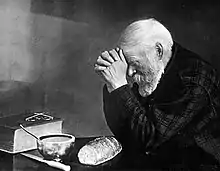 |
| Seal | Minnesota State Seal | Minnesota's official seal stresses the importance of farming through its depiction of a plowing farmer, standing near St. Anthony Falls on the Mississippi River; nearby is a Native American on a horse, who serves as a representation of the state's first peoples. The seal also contains the state motto, L'Étoile du Nord.[26][27] | 1861 | 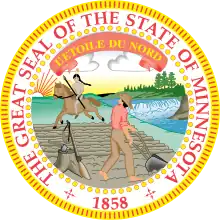 |
| Soil | Lester | Named after the town of Lester Prairie, Lester is a nutrient-rich soil ideal for the growing of pasture grasses and crops such as soybeans and corn. It is present in approximately sixteen Minnesota counties and covers over 400,000 acres.[28] Lester was chosen by the Minnesota Association of Professional Soil Scientists for fitting four criteria: it is based in Minnesota, is extensively located and economically important, and is photogenic. Minnesota is the 22nd state to have an official soil.[29] | 2012 | 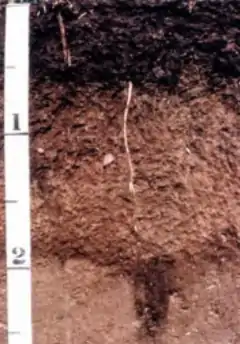 |
| Song | "Hail! Minnesota" | Between 1904 and 1905, Minnesota's state song was written by two University of Minnesota students; it served as the school's official song until 1945, when it was adopted as state song.[30] The "Minnesota Rouser" eventually replaced it as the university's official song.[31] | 1945 | 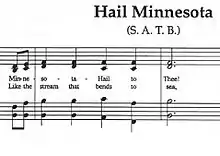 |
| Sport | Ice hockey | Minnetonka Middle School East students first proposed ice hockey as the state sport in 2007.[1] One of the children explained their choice, "One of the best reasons hockey should be our state sport is because Minnesota is the land of 10,000 lakes and they all freeze up to make great hockey rinks." The bill was co-sponsored by State Senator David Tomassoni, a former hockey player.[32] | 2009 |  |
| Tree | Norway pine (Pinus resinosa) |
The Norway pine, also known as the red pine, has historically been vital to Minnesota's economy, especially during its early settlement.[11] It can grow between 60 and 100 feet (18 and 30 m) tall. The tallest Minnesota specimen, which is over 300 years old, is found in Itasca State Park.[33] | 1953 | 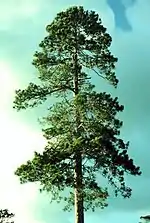 |
Nicknames and unsuccessful proposals

Minnesota has three nicknames: "Land of 10,000 Lakes", which evolved from the desire of early settlers to advertise the state's large number of lakes to attract more people; "Gopher State", which was inspired by an early political cartoon criticizing the construction of several railroads in the mid-1800s; and "North Star State", a reference to both the state motto and Minnesota's position as the northernmost point in the contiguous United States.[34][35] The Minnesota North Stars, the state's hockey team from 1967 to 1993, also derived its name from the state motto.[36]
Many other symbols have been proposed for addition to the list of official state symbols but were never officially adopted. Since 1971, the white-tailed deer has been proposed as the state mammal eight times.[37] Other creatures proposed as representations of the state have included the northern leopard frog, the eastern timber wolf, the thirteen-lined ground squirrel, and the Blanding's turtle.[34] In 2007, another proposal, also unsuccessful, was to designate the Tilt-A-Whirl as the state's official amusement ride. It was invented in Faribault in 1926, and debuted at the Minnesota State Fair a year later.[34][38]
In 2005, the state legislature overwhelmingly voted in favor of appointing a state poet laureate, a position offered by 34 other states. Governor Tim Pawlenty vetoed the measure, believing that the state could "benefit from the richness and diversity of all of the poets in Minnesota and recognize and embrace their work as merit and circumstances warrant."[39] "Minnesota Blue", a 1985 poem by state native and poet-songwriter Cordell Keith Haugen, has been unsuccessfully proposed as state poem. Five other states have official poems.[40][41] Proposals for state book have included two of Laura Ingalls Wilder's works, Little House on the Prairie and On the Banks of Plum Creek.[34]
In 2016, Minnesota proposed to make purple its official color in honor of the musician Prince; however, the motion did not succeed.[42][43]
See also
References
- 1 2 3 4 5 6 7 8 9 10 11 12 "Minnesota Legislature List of Official Symbols". State of Minnesota. Archived from the original on February 17, 2014. Retrieved December 29, 2013.
- ↑ Gunderson, Dan (May 31, 2019). "Meet the rusty patched bumblebee, Minnesota's new bee ambassador". NPR News. Archived from the original on June 5, 2021. Retrieved June 5, 2021.
- ↑ "State Drink". State of Minnesota. Archived from the original on 2014-01-16. Retrieved January 15, 2014.
- ↑ "State Bird". State of Minnesota. Archived from the original on 2014-01-16. Retrieved January 15, 2014.
- ↑ Youso, Karen (April 7, 2003). "Common loon was made state bird in 1961". Star Tribune. Archived from the original on June 11, 2014. Retrieved January 16, 2014. (subscription required)
- ↑ McAuliffe, Bill (February 15, 2000). "Monarch butterfly is king of State Capitol for a day; A bill to make the beautiful orange flash the state butterfly took flight on political winds fanned by eager (and well-educated) fourth-graders". Star Tribune. Archived from the original on June 11, 2014. Retrieved January 15, 2014. (subscription required)
- ↑ "State Butterfly". State of Minnesota. Archived from the original on 2014-01-16. Retrieved January 15, 2014.
- ↑ Gilbert, Jim (June 2, 2006). "As apt symbol, the walleye has it". Star Tribune. Archived from the original on March 24, 2016. Retrieved January 16, 2014. (subscription required)
- ↑ "State Fish". State of Minnesota. Archived from the original on 2014-01-16. Retrieved January 15, 2014.
- ↑ "State Flag". State of Minnesota. Archived from the original on 2014-01-16. Retrieved January 15, 2014.
- 1 2 3 4 5 McPherson 2013, p. 49.
- ↑ "State Flower". State of Minnesota. Archived from the original on 2014-01-16. Retrieved January 15, 2014.
- ↑ Giles, Kevin (March 25, 2006). "The Apple of their eye; Bayport fifth-graders want the Honeycrisp, a homegrown variety, to be Minnesota's official fruit". Star Tribune. Archived from the original on June 11, 2014. Retrieved January 15, 2014. (subscription required)
- ↑ "State Gemstone". State of Minnesota. Archived from the original on 2014-01-16. Retrieved January 15, 2014.
- ↑ "State Grain". State of Minnesota. Archived from the original on 2014-01-16. Retrieved January 15, 2014.
- ↑ Levy, Paul (October 5, 2005). "Research treading on sacred ground; A clash over genetically altered wild rice pits advancing science against deeply held Indian spirituality". Star Tribune. Archived from the original on May 29, 2007. Retrieved January 15, 2014. (subscription required)
- ↑ Meier, Peg (January 5, 2005). "Capitol quirks; Happy 100th birthday, Minnesota State Capitol. My really huge marble dome dominates the sky. Here are some other sweet things you may not know". Star Tribune. Archived from the original on June 11, 2014. Retrieved January 18, 2014. (subscription required)
- ↑ "State Muffin". State of Minnesota. Archived from the original on 2014-01-16. Retrieved January 15, 2014.
- ↑ Vulliamy, Ed (August 20, 1988). "Highway 61 Newly Revisited; Big Business for Duluth but Bad News for Dairy Farmers Along the Midwestern Route". The Washington Post. Archived from the original on June 11, 2014. Retrieved January 17, 2014. (subscription required)
- ↑ "State Mushroom". State of Minnesota. Archived from the original on 2014-01-16. Retrieved January 15, 2014.
- ↑ Gilbert, Jim (May 14, 2007). "Outdoors Journal; Save room for the state 'shroom". Star Tribune. Archived from the original on June 11, 2014. Retrieved January 15, 2014. (subscription required)
- ↑ Walsh, Paul (February 28, 2012). "She brought 'Grace' photo to fame". Star Tribune. Archived from the original on June 11, 2014. Retrieved January 17, 2014. (subscription required)
- ↑ "Grace official state photograph". State of Minnesota. Archived from the original on 2014-01-16. Retrieved January 15, 2014.
- ↑ Brunswick, Mark (March 15, 2001). "Legislator is seeking stamp of approval for famous photo; A resolution, introduced in the hope that "Grace" will grace the nation's mail one day, passed a House committee". Star Tribune. Archived from the original on June 11, 2014. Retrieved January 15, 2014. (subscription required)
- ↑ "Woman who colorized 'Grace' photo dies at 95". Associated Press. February 27, 2012. Archived from the original on June 11, 2014. Retrieved January 17, 2014. (subscription required)
- ↑ "State Seal". State of Minnesota. Archived from the original on 2014-01-16. Retrieved January 15, 2014.
- ↑ McAuliffe 2003, p. 9.
- ↑ "Lester soil (official Minnesota state soil)" (PDF). Minnesota Conservation Volunteer: 64–65. May–June 2013. Retrieved February 12, 2014.
- ↑ Larson, Eric (August 1, 2012). "Famed for its Dirt; Minnetrista Farm Has a Prime Example of the New State Soil, Boosting Educational Programs". Star Tribune. Archived from the original on June 11, 2014. Retrieved January 15, 2014. (subscription required)
- ↑ "State Song". State of Minnesota. Archived from the original on 2014-01-16. Retrieved January 15, 2014.
- ↑ "Minnesota Rouser". University of Minnesota. Retrieved June 26, 2017.
- ↑ Relerford, Patrice (March 6, 2008). "Young puck fans make pitch for state sport; Two Minnetonka sixth-graders told a Senate committee of hockey's importance in the state, and the panel agreed". Star Tribune. Archived from the original on June 11, 2014. Retrieved January 17, 2014. (subscription required)
- ↑ "State Tree". State of Minnesota. Archived from the original on 2014-01-16. Retrieved January 15, 2014.
- 1 2 3 4 "Minnesota State Symbols—Unofficial, Proposed, or Facetious". State of Minnesota. Archived from the original on February 3, 2014. Retrieved January 18, 2014.
- ↑ McAuliffe 2003, p. 7.
- ↑ "Minnesota North Stars (1967–1993)". Sportsecyclopedia.com. Retrieved February 12, 2014.
- ↑ Brooks, Jennifer (May 6, 2012). "Serving up all things political, from Minnesota to D.C. This soil stands out in its field". Star Tribune. Archived from the original on June 11, 2014. Retrieved January 18, 2014.
- ↑ "Minn. Lawmaker Lobbies for Tilt-a-Whirl". Associated Press. March 30, 2007. Archived from the original on June 11, 2014. Retrieved January 18, 2014. (subscription required)
- ↑ DeFiebre, Conrad; Williams, Sarah T. (June 1, 2005). "State poet? Pawlenty opts to forgo it; Laureate proposal vetoed despite strong legislative support". Star Tribune. Archived from the original on January 4, 2007. Retrieved January 18, 2014.
- ↑ "Minnesota Blue Minnesota Poem". State of Minnesota. Archived from the original on 2013-12-11. Retrieved January 18, 2014.
- ↑ Hertzel, Laurel (February 14, 2013). "State Poem: It Rhymes, but Is There Reason? Not Everyone Agrees That "Minnesota Blue," by a Hawaiian Singer-Songwriter, Should Represent the State". Star Tribune. Archived from the original on June 11, 2014. Retrieved January 18, 2014. (subscription required)
- ↑ "Minnesota SF3595 2016".
- ↑ "Purple as the official state color? Prince would approve". 23 April 2016.
- Works cited
- McAuliffe, Bill (2003). Minnesota Facts and Symbols. Mankato, MN: Capstone Press. ISBN 9780736822534.
- McPherson, Alan (2013). State Botanical Symbols. Bloomington, IN: AuthorHouse. ISBN 9781481748858.